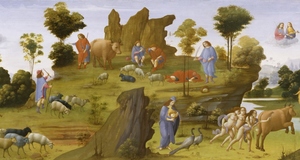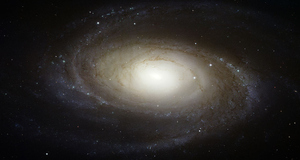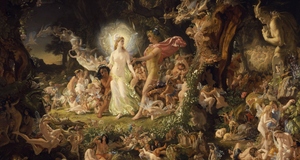A 16th Century Ovid: The Influence of Classical Mythology on the Understanding of Shakespeare's Plays
By
2017, Vol. 9 No. 02 | pg. 1/1
KEYWORDS:
Commonly believed to be the single greatest writer and poet of the English language, as well as one of the most distinguished and esteemed dramatists in the entire world, William Shakespeare is credited with authoring approximately 38 works of theatre, 154 sonnets, two lengthy narrative poems, and several additional pieces of verse. While there exists some question concerning the authenticity of authorship of several of these dramatic works, scholars have determined that 32 of the 38 plays can unquestionably be attributed to Shakespeare (Root 119-132). With the majority of the writing of his known works occurring between 1589 and 1613, both Shakespeare’s comedies and tragedies were heavily influenced by the resurgence in popularity of classical mythology, particularly the works of the Roman writer, Ovid, that took place during the early-Elizabethan period. Following Arthur Golding’s “monumental translation” of the fifteen books comprising the Metamorphoses in their entirety in 1567, the English people began to regard Ovid as an unparalleled mythographer and a valuable source of literary inspiration (Roe 32). As Shakespeare’s plays are fraught with mythological allusions, it is obvious that the great English playwright is no exception to this way of thinking. Containing both elaborate, detailed allusions for which a definite source can be easily identified and more vague, generalized references with no immediately obvious source, Shakespeare’s literary mythology is overwhelmingly Ovidian in nature, with the Metamorphoses supplying the bulk of the basis for these well-known allusions (Taylor 3). The abundance of mythic allusions present in nearly all of Shakespeare’s works are evidence of the continued cultural influence of Greek and Roman mythology in the period during which he wrote. The abundance of mythic allusions present in nearly all of Shakespeare’s works are evidence of the continued cultural influence of Greek and Roman mythology in the period during which he wrote. At the same time, they highlight the importance of the readers’ previous knowledge of classical mythology in order to fully experience Shakespeare’s work. When examined with special attention to the classical mythological influence, Shakespeare’s comedy A Midsummer Night’s Dream epitomizes the dynamic role of classical mythology in literature of both providing context for the events of the play and helping the reader to come to a fuller understanding of the implications associated with Shakespeare’s chosen allusions.Regarded by many scholars as one of Shakespeare’s “most Ovidian” works, second only to the long narrative poem Venus and Adonis, the comedy A Midsummer Night’s Dream is saturated with references to classical mythology spread throughout the entirety of the play (Velz 185). Excluding the unavoidable specific references to characters in the play, this theatrical piece contains approximately 37 individual mythological allusions. Of these 37, ten are either definitively drawn from Ovid or contain reasonable traces of Ovidian influence, with the other allusions ranging from the work of Vergil, to pagan-based nature myths, to numerous mentions of various Greek and Roman deities (Root 122). Believed to be written between 1590 and 1595, this play is representative of the humorous and playful treatment of mythology that characterizes Shakespeare’s earlier works composed when the influence of Ovid is most evident within his writing. Like his contemporaries, Shakespeare found in Ovid, and by extension the whole of classical mythology, a “treasure-house of fascinating stor(ies)” with previously established and easily recognizable plots and morals (Root 8). The influence of these selected allusions, although treated whimsically, adds a deeper level of meaning to an otherwise light-hearted production, while simultaneously affecting the readers’ interpretation of this comedic work. Beginning by examining allusions drawn from outside the realm of Ovidian mythology, Shakespeare’s character of Theseus, Duke of Athens, can be traced to the portrayal of the Athenian hero found in Thomas North’s translation of Plutarch’s work Lives of the Noble Greeks and Romans (Root 111). The Theseus of antiquity is often considered to be the greatest Athenian hero and is recognized for his unique combination of physical and intellectual strength; however, that is not the picture painted by Shakespeare. In A Midsummer Night’s Dream, the love-struck Duke is first introduced before his “nuptial hour” to the Amazonian Hippolyta lamenting how slowly the remaining four days appear to be passing (1.1.1). In addition to the narrative of his capture of and subsequent marriage to Hippolyta featured in Shakespeare’s play, many variations of the original myth of Theseus also include detailed accounts of Theseus’s previous romantic endeavors (Grant and Hazel 326). These tales of his encounters with women like Antiope, Perigenia, and Aegle are not directly incorporated into the comedy’s storyline by Shakespeare; instead, he relies on readers being familiar with the classical mythology surrounding Theseus to convey important aspects of the Duke’s character. For instance, Oberon, the king of the fairies, accuses his wife, Titania, of being secretly in love with Duke Theseus by stating that she “led him through the glimmering night/ from Perigenia” and aided him in obtaining mistresses in the forms of “fair Aegles…with Ariadne, and Antiopa” (2.1.77-80). Through the simple inclusion of this brief reference to Theseus’s former and tumultuous affairs, Shakespeare calls into question the sincerity of Duke’s initial speech and apparent impatience regarding his impending wedding to Hippolyta. By invoking these specific episodes from the extensive narrative of Theseus, Shakespeare relies on the influence of classical mythology to subvert the idea of Duke Theseus as a sensitive, caring lover and remind readers of the promiscuous, callous warrior that he truly is. Like Theseus, the characterization of Hippolyta has roots in North’s translation of Plutarch’s iconic work. In fact, Shakespeare’s change in spelling from the traditional “Ipolita” used by Chaucer to his preferred “Hippolyta” is the direct result of the powerful influence of North’s handling of the original Greek text (Root 111). In keeping with the Hippolyta espoused by Shakespeare, traditional mythology confirms his version of Hippolyta as the reluctant, battle-won bride of the formidable Athenian hero, Theseus (Root 112). While Shakespeare chooses not to include the details of Hippolyta’s past adventures within the confines of this play, they are the subject of much myth-making and provide important insights into the narrowly developed character present in Shakespeare’s comedy. Although Theseus does make mention of the fact that he “wooed [her] with his sword/ and won [her] love doing [her] injuries,” he does not elaborate on the underlying cause of said battle (1.1.16-17). According to one version of the myth surrounding Hippolyta, during Theseus’s campaign against the Amazons of Themiscyra, the great warrior captured Antiope, Hippolyta’s sister, and proceeded to carry her back to Attica. Devastated and enraged at the loss of her sister, the Amazonian queen, accompanied by the rest of her man-hating tribe, launched an attack on Theseus’s kingdom. Even though the Amazons are said to have controlled the hill of Pnyx, Theseus is ultimately victorious. Hence, Antiope withdraws to Megara, where she dies. Hippolyta, now mourning the death of her beloved sister, is taken as Theseus’s prisoner and forced to marry her captor. In many variations, Hippolyta is forced to undergo the ultimate form of subjugation for an Amazon: she is forced to bear Theseus’s son, Hippolytus (Grant and Hazel 176). Although she is portrayed neutrally and is restricted to few lines of speech, the knowledge of these crucial events in Hippolyta’s mythology influences the readers’ impression of her underdeveloped character. By employing this reference to Hippolyta, Shakespeare is able convey her justified unwillingness to marry Duke Theseus without having to include a detailed retelling of the events that have led to her and the Duke’s looming marital hour. Easily the most prominent and well-developed allusion in all of Shakespeare, the presence of the rude mechanicals’ version of Pyramus and Thisbe leads to the “delicious burlesque” of an originally somber Ovidian story (Root 11). As told in Book Four of the Metamorphoses, the story of Pyramus and Thisbe is the tragic tale of the two most beautiful Babylonian youths who have fallen in love with each other and desire to move towards marriage. Because their fathers have forbidden their romance, the young lovers are resigned to communicating solely through the hole in their shared wall. This separation and secrecy only makes their passions burn hotter, finally causing them to make plans to meet under cover of night outside the city. When she reached the rendezvous point, Thisbe is frightened by a lion and drops her veil. Pyramus, seeing the blood-stained shawl lying on the ground, assumes his beloved to have been killed and commits suicide. Shortly thereafter, Thisbe returns and, finding Pyramus’s corpse, follows suit and kills herself (Kline). While the gravity of this story is undeniable, Shakespeare manipulates and satirizes the same features that cast Ovid’s original as a romantic tale to show the production of the tradesmen as a complete farce, thereby forcing readers to confront the wider implications and influence the presence of this myth wields over the remainder of the play. Shakespeare introduces the inversion and manipulation of traditional mythology from the first moment Bottom and his fellow tradesmen begin contemplating performing a play for the Duke’s upcoming wedding. When searching for a suitable drama, Peter Quince proposes that the hodgepodge troupe put on a play entitled “The Most Lamentable Comedy and Most Cruel Death of Pyramus and Thisbe” (1.2.8-9). This obvious combination of paradoxical adjectives in the title of mechanicals’ play can be viewed as Shakespeare’s deliberate attempt to add an element of humor to the otherwise grave narrative, accordingly setting the stage for the rest of the group’s equally entertaining and disastrous performance. Shakespeare goes on to include such verbal absurdities as Bottom’s line, “I see a voice; now will I to the chink/ to spy an I can hear my Thisbe’s face” (5.1.190-191) and his unnecessary description of the night as being “ever art when day is not” (5.1.169). As Bottom speaks both of these lines while playing the role of Pyramus, they serve to undermine the readers’ perceptions of the mythological Babylonian youth as a serious, mature, knowledgeable character by depicting him as a good-intentioned but bumbling fool. Along the same lines, Shakespeare takes full advantage of the Latin possessive structure ad busta Nini, meaning “the tomb of Ninus,” (Rudd 116) in his rendering of Pyramus’s request for Thisbe to “meet [him] at Ninny’s tomb straightway” (5.1.200). These oral blunders, combined with Thisbe’s repeated distorted allusions to “Ninny’s tomb” (5.1.252) and her breaking of the metaphorical fourth wall in the closing of her dying speech with “adieu, adieu, adieu,” (5.1.335) work to destroy the illusion of legitimacy typically created by the theatre, thus shattering any possibility of readers familiar with the traditional Ovidian tale viewing this moment of meta-theatre as a viable source of meaning or a fulfillment of the original myth’s pathos. By making it impossible for Bottom and his colleagues to be taken seriously as their respective classical characters, Shakespeare forces readers to search for echoes of Ovid’s classical mythology in a different source within his own play. In the gauche version of the myth presented by Bottom’s ensemble of rude mechanicals, the story of Pyramus and Thisbe parodies the relationship of Lysander and Hermia. Just as Pyramus and Thisbe’s youthful love has been prohibited by their fathers, Hermia’s stern, controlling father, Egeus, has proscribed her from marrying her chosen suitor and is insisting that she submit to his will by marrying Demetrius (1.1. 22-27). In response to his demands, Hermia begs the penalty of disobedience but not before asserting that she “know(s) not by what power [she] is made bold” (1.1.59). This phrase seems to be the direct result of Shakespeare’s familiarity with Ovid’s rendition of Thisbe, whose motivations are explained by the phrase audacem faciebat amor, which translates to “Love made her bold” (Rudd 119). The parallels between the accounts of starry-eyed love found in Ovid and Shakespeare carry over into Lysander’s response to their seemingly hopeless situation. When faced with the impasse of his beloved either being put to death or becoming a nun, the young Athenian boy appeals to Hermia by saying, “If thou lovest me then/ Steal forth thy father’s house tomorrow night/And in the wood, a league without the town” will he meet her (1.1.163-165). This description of the young lovers’ plan echoes Pyramus and Thisbe’s resolve “to steale out of their fathers house and eke the Citie gate…they did agree at Ninus Tomb to meete without the towne” (Rudd 119). Here, Shakespeare’s deliberate and overt borrowings from Ovid serve to provide readers with a sort of “distorted mirror-image” of potentially tragic romantic love (Rudd 118). By utilizing the influence of classical mythology in this manner, Shakespeare effectively complicates and adds an element of seriousness to a depiction of love that on its own could be considered too sweet, naïve, idealized, and sentimental. Throughout the drama, Shakespeare’s repeated and extensive incorporation of elements from classical mythology into A Midsummer Night’s Dream adds a second level of meaning to that already present in the text of the play. By calling upon iconic characters from antiquity in the forms of Theseus and Hippolyta, Shakespeare is able to successfully invoke the influence of these characters’ respective and entangled myths to not only give readers a truer sense of his own characters, but also to provide context for their actions within the comedy. Through his inclusion of the distorted and caricatured telling of Ovid’s Pyramus and Thisbe, the playwright requires readers to look elsewhere for the gravitas traditionally associated with this tragic tale. In doing so, Shakespeare lends a sense of seriousness and legitimacy to his account of the relationship between Lysander and Hermia that would otherwise be overshadowed by the lunacy and hilarity of their misadventures in the woods. Ultimately, the influence of Ovid’s Metamorphoses over the writings of Shakespeare is neither confined to his casting of Theseus and Hippolyta nor to the theme of young love depicted by Hermia and Lysander but is felt, albeit in varying degrees of significance and strength, over the course of the entire play. ReferencesGrant, Michael and John Hazel. Who’s Who in Classical Mythology. Oxford University Press, 1993. Print. Ovid. “Book IV.” Metamorphoses. Trans. A.S. Kline. The University of Virginia, 1999. Web. Accessed 6 December 2016. http://ovid.lib.virginia.edu/trans/Metamorph4.htm. Root, Robert Kilburn. Classical Mythology in Shakespeare. Edward Brothers, Inc., 1903. Print. Rudd, Niall. “Pyramus and Thisbe in Shakespeare and Ovid.” Shakespeare’s Ovid: The Metamorphoses in the Plays and Poems. Edited by A.B. Taylor, Cambridge University Press, 2000. Print. Shakespeare, William. A Midsummer Night’s Dream. The Norton Shakespeare Anthology: Essential Plays and Sonnets, edited by Stephen Greenblatt, et all, W.W. Norton & Company, 2016, 209-268. Print. Taylor, A.B. “Introduction.” Shakespeare’s Ovid: The Metamorphoses in the Plays and Poems. Edited by A.B. Taylor, Cambridge University Press, 2000. Print Velz, John W. “Shakespeare’s Ovid in the Twentieth Century: A Critical Survey.” Shakespeare’s Ovid: The Metamorphoses in the Plays and Poems. Edited by A.B. Taylor, Cambridge University Press, 2000. Print Suggested Reading from Inquiries Journal
Inquiries Journal provides undergraduate and graduate students around the world a platform for the wide dissemination of academic work over a range of core disciplines. Representing the work of students from hundreds of institutions around the globe, Inquiries Journal's large database of academic articles is completely free. Learn more | Blog | Submit Latest in Literature |
















